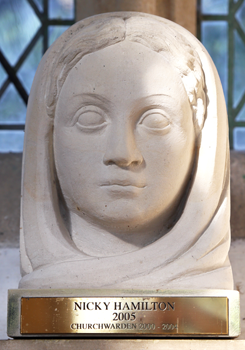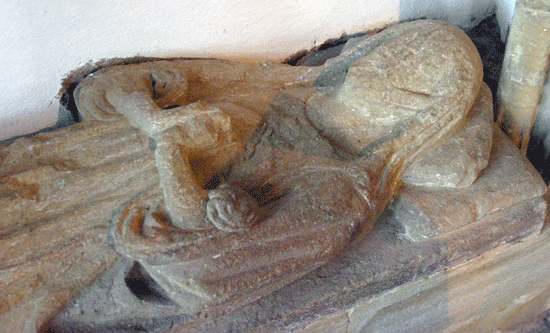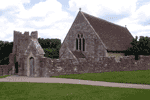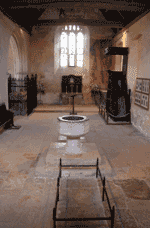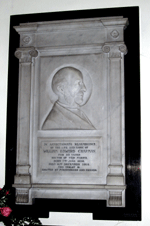| SOMERSET - 3 |
Somerset Pages: <Somerset 1> <Somerset 2> <Somerset 4> <Somerset 5> <Somerset 6> <Somerset - Wells>
 |
Ditcheat - St Mary Magdelene |
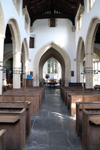 |
| Church open. Park
outside on the road - plenty of room O/S Ref: ST 626 363 |
 |

|
|
| Above top and left: Priest early 14th century. Above bottom: Nicky Hamilton (2005) Churchwarden. On windoe sill |
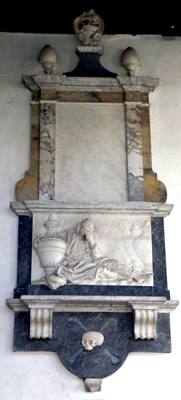 |
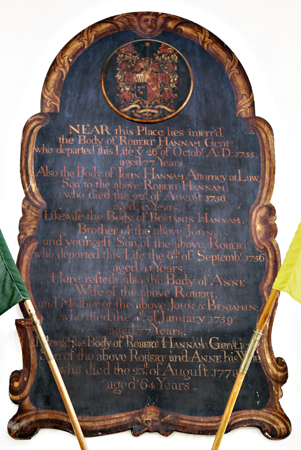 |
 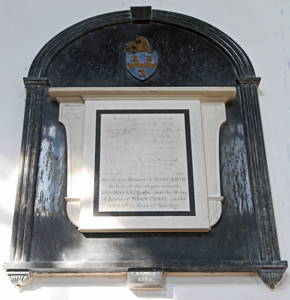 |
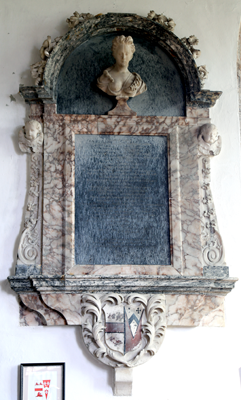 |
| Worn to illegibility | Robert Hannam (1755). Also, his sons: John Hannam (1756) attorney-at-law, and Benjamin Hannam (1756). Also, Robert's wife, Ann (1759). Also Robert and Ann's son, Robert Hannam (1778). | Top: Ann Randall Goodfellow (Hannam)
(1803) Bottom: Thomas Lier (1812) Rector of the Parish, and his wife, Mary Leir (1829). Signed:T King Ft Bath |
Illegible |
 |
There are a number of
monuments similar to that shown on the left but not they are not
identical. All have a shield of arms. That shown is to: Major General Richard Lanford Leir (1933) and his wife, Henrietta Anne, Baroness Dorchester (1925) As well as the shileld of arms this monument also displays a regimental badge |
|
|
Rev Marriott Leir (1811) MA (1891) and his
wife, Mary Anne (Longford) (1889) The inscription then continues: 'He was Lord of and Patron of the Rectorial Manor of Ditchett and also Lord of the Manor of Allhampton. Now we know why and how a church appointment is kept in the family. |
||
| The following are designed as a pair, the shield of arms being shared and between the two monuments: | ||
| Thomas Lier MA (1730) Rector, and his wife, May (Freke) (1737) | ||
| Rev Thomas Leir MA (1781) and his wife, Elizabeth (Methuen) (1783) | ||
| Richard Leir (1850) Son of Thomas, Rector. | ||
| Rev William Leir MA (1863) and his wife, Harriott (Marrot) (1843) | ||
| Other Monuments | ||
Thomas Lie (1803) Son of Rev Thomas Lie, Rector |
White oval talet on black base. Signed: T King Fn Bath | |
| Charles Edward Lier MA (1924) Rector for 26 years | White tablet | |
| Henry Howard Tapp MA (1945); and his wife, Mildred (Lier), Daughter of Charles Lier MA | White tablet | |
| Dowlish Wake - St Andrew Lady c 1300 John Speake (1442) & Wife tc with effigies George Speake (1528) brass John Henning Speake (1864) bust |
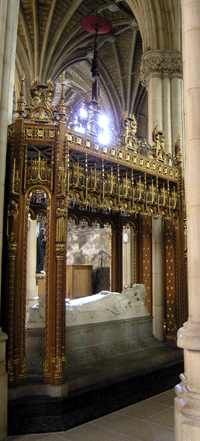 |
Downside Abbey |
 |
 |
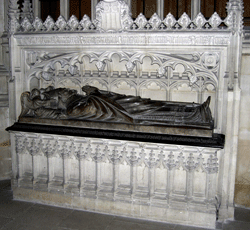 This is a working Benedictine community which was re-established in England in 1795. The present buildings were begun in 1872. These are the modern monuments of the abbots, all in a medieval style. Unfortunately I have been unable to name many of them. Left: Cardinal Gasquet (1929) Designed by Sir Giles Gilbert Scott and carved by E. Carter |
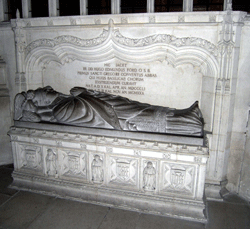 |
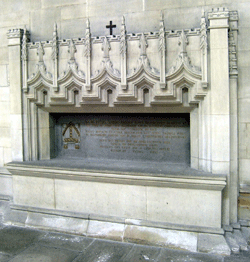 |
 |
| Abbot Ford | Abbot Ramsay (1929) by Scott |
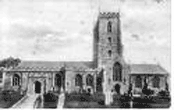 |
Dunster - St George |
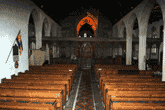 |
| Church open during normal hours. There is limited parking in the town; otherwise use the relatively expensive pay and display car park a five to ten minute somewhat difficult walk to the church. O/S Ref: SS 991 437 |
| Chancel |
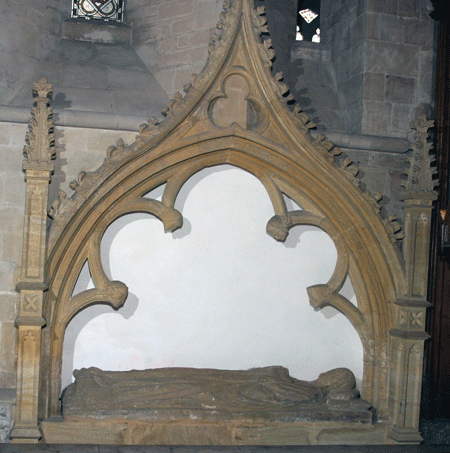 |
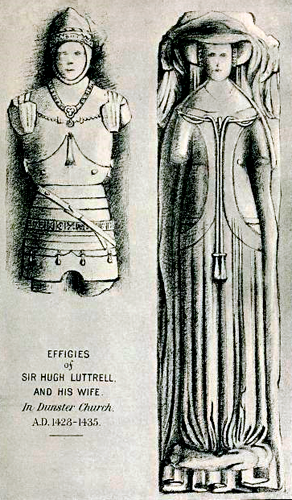 |
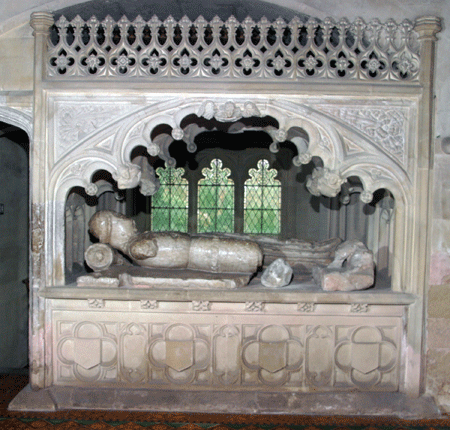 |
|||

 |
|||||
|
|||||
| Nave | South Transept |
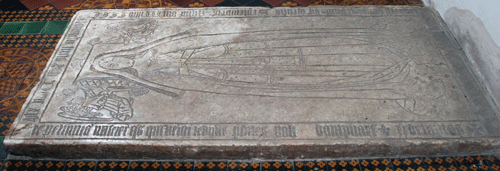 |
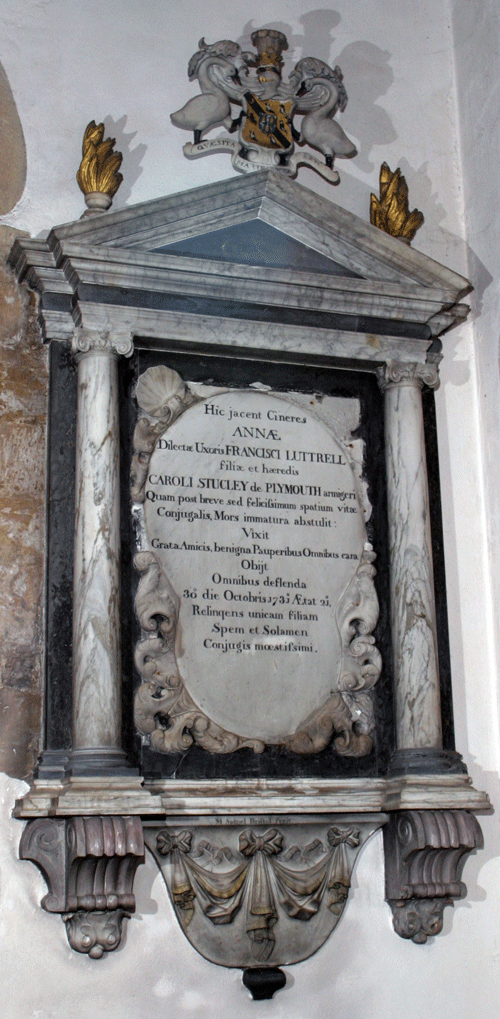 |
| Above: Lady Elizabeth Luttrell (1493). Incised alabaster slab. Right: Mrs Ann Luttrell (1731). By M S idnell of Bristol (signed) Below: Thomas Luttrell (1571) and his wife, Margaret (Hadley) and George Luttrell (1629) and his wife, Joan (Stuckeley) (1613). This monument was set up by George (the kneeling figure) after the death of his wife. He married a second time. For Thomas also visit here |
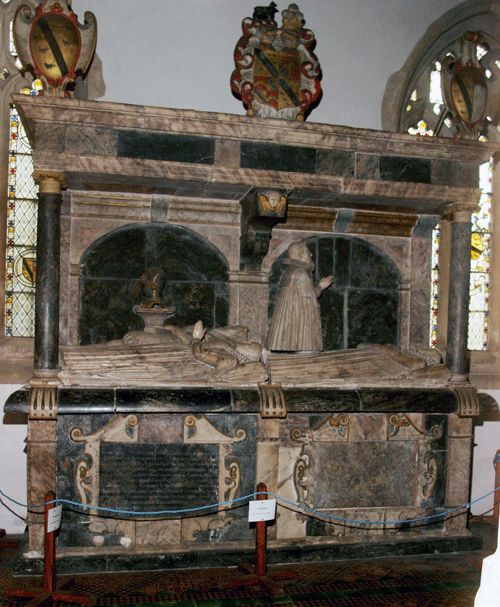 |
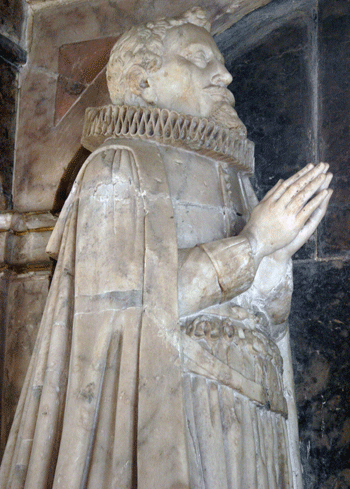 |
|
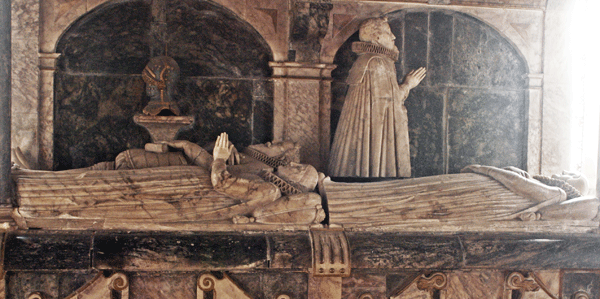  |
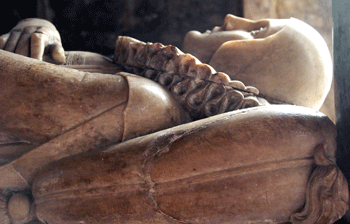
| East Brent - St Mary 2x priests mid 14th C Reed children 1869 signed Casentini & Co |
East Coker - St Michael Lady E 14th C Male Civilian M 14th C |
East Harptree - St Laurence Sir John Newton 1568 TC with recumbent effigy (now south porch) |
| Easton-in-Gordano - St
George Roger Soudon 1703 portrait bust |
East Pennard - All Saints G Martin (1789) by King of Bath E Berkeley Napier (1799) by same |
East Quantoxhead - St Mary Hugh Kuttrell (1522) TC, canopy |
|
|
Farleigh Hungerford Castle Chapel (St Leonard's Chapel) |
|
| The castle and its chapel are under the care of English Heritage. For cost of entrance fee and hours of opening - which can vary according to the time of year - visit www.english-heritage.org.uk/farleighhungerford. Car parking and photography are included in the charge. O/S Ref: ST 801 577 |
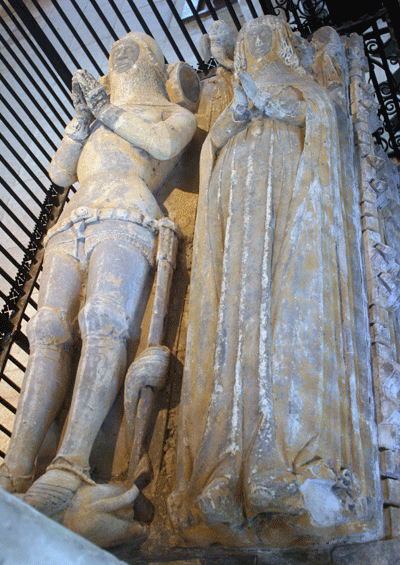 |
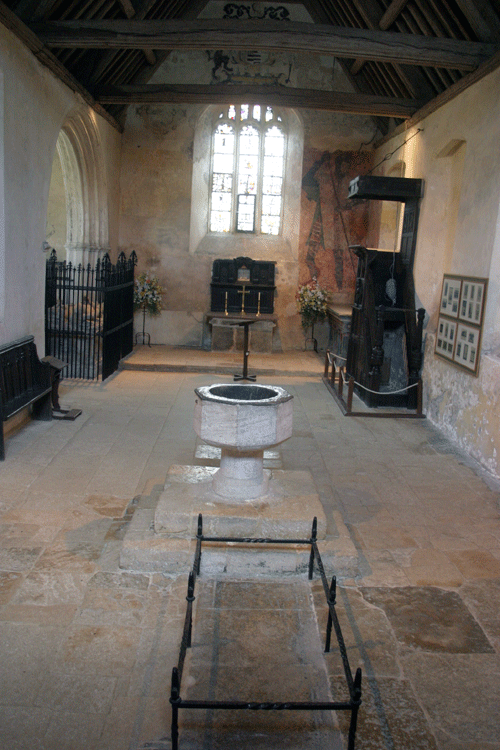 |
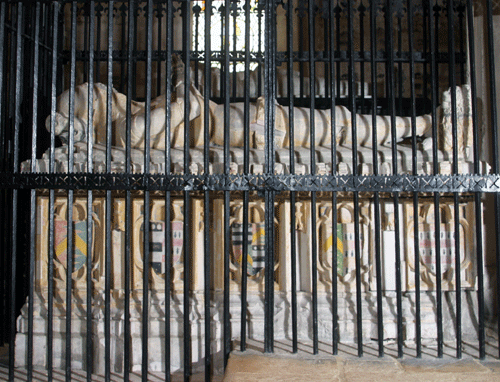 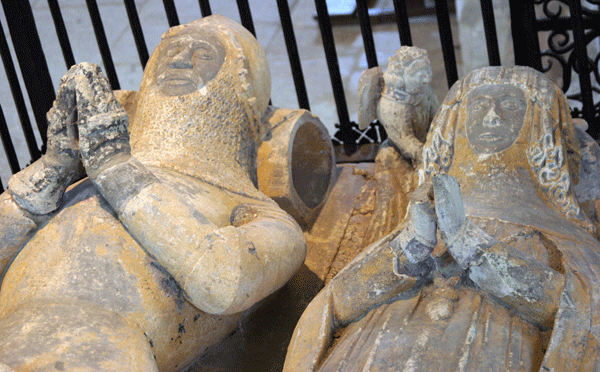 |
| Above Centre: Overall view of the St Leonard's
Chapel. The incised slab to the chantry priest can be
seen, railed, in the foreground. Behind this is the font
and some of the tombs can be made out in the background
as well as a wall painting. An arch to your left leads
into an adjoiningSt. Anne's Chapel. To the Left and Right: Sir Thomas Hungerford (1398) & Joan He was the founder of the castle. Below Left to Right: i) Sir Walter Hungerford IV (1596) Chancel: this and the tomb chest on the far right are similar but not identical. ii) Mary Shaa (1613). The slab is plain: she kneels with her family at the front. Sister of Sir Walter IV & Sir Edward II iii) Sir Edward Hungerford II (1607) Chapel . Both this and that of Sir Walter have deeply incised inscriptions on the top. slab. |
||
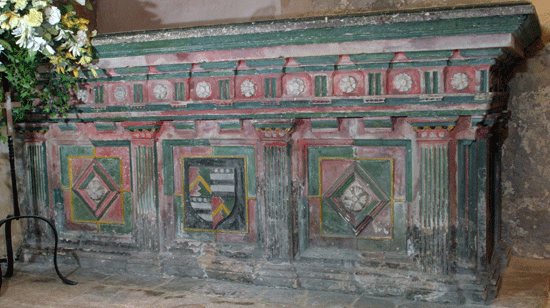 |
 |
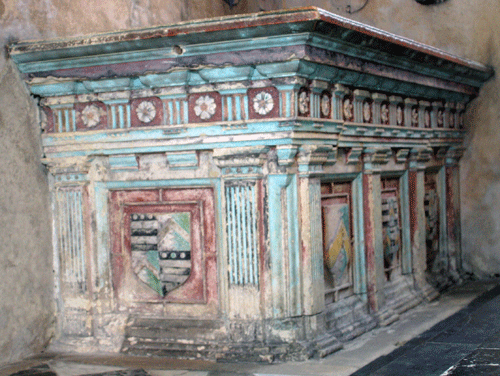 |
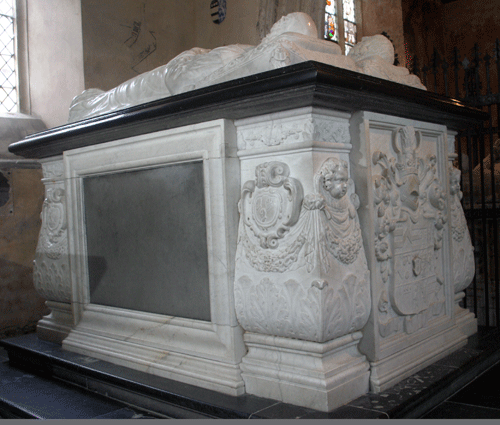 |
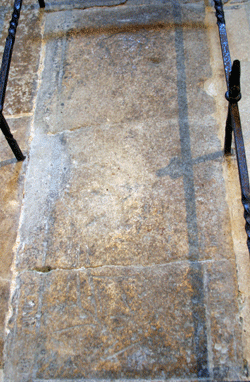 |
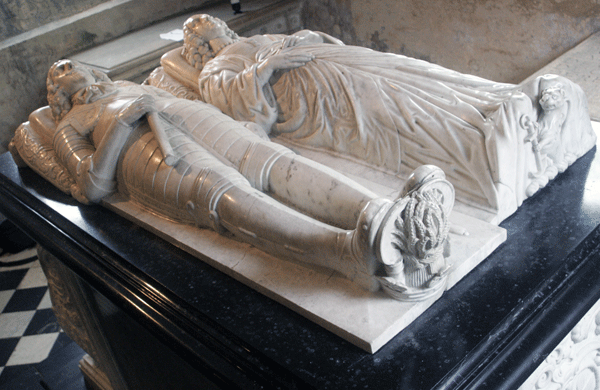 |
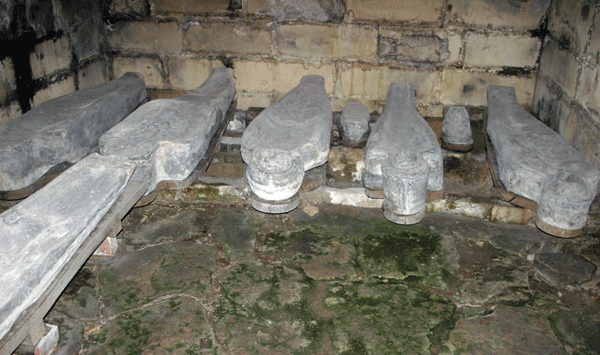 |
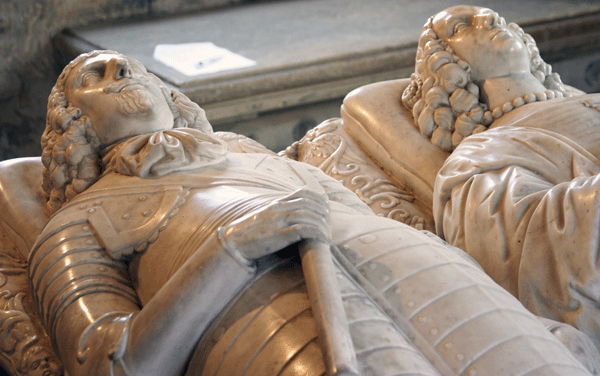 |
|
Above Top Row Left & Right
and Bottom Row Right: Sir Edward Hungerford III
(1648) &
& Margaret (Hallyday (1672) See below Top Row Centre: Incised slab to a chantry priest c 1500 Very worn but the head and shoulders can just be made out below the shadow of the top cross bar. Bottom Row Left: Curiosity: Lead Coffins in the Crypt. Lead coffins were in use from about 1500-1650, some of which were anthropomorphic in shape. They were originally contained in an outer wooden cases, which have now decayed. Some of these coffins have the face of the deceased moulded onto them; sometimes this moulding may be actually taken from a death mask but it is unlikely that this was the case at Farleigh Hungerford.There are eight such coffins at Farleigh Hungerford: four adult males, two adult females and two children. Four of these have faces moulded on them. The coffins contain the remains of the following, among others: Sir Edward III & Margaret (Hallyday) Jane Hele (1664), wife of Sir Edward IV Edward (1689), their son Alathea, his wife |
|
| Sir Edward Hungerford III |
| Sir Edward Hungerford was elected to both the short and long parliaments and joined the parliamentary side when the civil war broke out in 1642. He fought under Sir William Waller at the battles of Lansdown and Roundway Down; he was also present at the siege of Wardour Castle. He attacked Farleigh Castle which was commanded by Colonel John Hungerford, possible his half brother, and which surrendered in 1645; according to the rules of warfare he took possession and remained there where he died in 1648. |
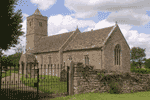 |
Farleigh Hungerford - St Leonard Parish Church |
| I made an
unplanned visit to the parish church of Farleigh Hungerford when
I visited the castle. Unfortunately it was firmly locked and
there was no indication on the notice board on the entrance to
the church yard nor one on the actual church notice board from whom to obtain the key.
Not a good practice. The monuments are: 1. Dorothea Torriano Houlton (1799) & John Houlton (1839) 2. Mrs Shirley (1828) & 3. Lady Wilson (1864) |
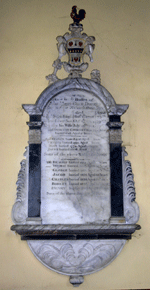 |
Farrington Gurney - St John the Baptist |
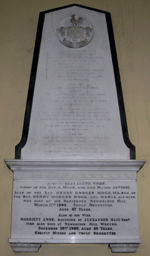 |
||
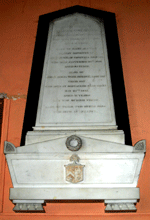 |
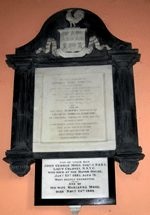 |
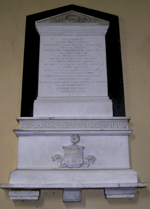 |
||
| A collection of wall monuments to the Mogg Family; all from the 19th century except the first which dates from the 18th and predates the church | ||||
|
|
|||||||||||
|
Frome - St John cadaver effigy Lucy (1827) and Lousia (1826) Boyle by Westmacott Isabella, Countess of Cork (1843) by Westmacott the Younger Richard Stevens (1796) by Thomas Cooke George Locke (1735) by T Paty |
Series To be continued |
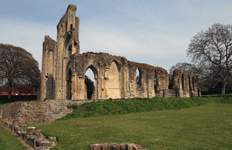 |
Glastonbury |
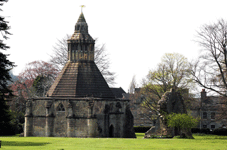 |
| St John's Church is open during daylight
hours. The Abbey is in ruins and under the care of English
Heritage.There is an entrance fee but the Abbey is well
cared for and organised; the excavated artifacts are now
housed in a museum, where there is plenty of information
about the Abbey. The museum is conveniently situated
next to the entrance hall. There is a pay and display car park convenient for Church and Abbey. Relatively expensive. Left: the abbey church from the cloisters. Right: the abbot's kitchen and ruins of living quarters. O/S Ref: ST 500 390 |
| St John's Church |
| The church was closed for repairs when
we visited; it is normally open Richard (1476) & Jane (1485) Atwell 2 tc's brasses lost John Camell 1470 alabaster effigy TC open lid |
| The Abbey |
| The Anglo-Saxon Chronicle states
(1016) King Edmund [Ironside] passed away and is buried with
his grandfather Edgar in Glastonbury. Florence of
Worcester states (946) [Edmund I] ... was
killed...his body was carried to Glastonbury and buried there.
(975) ... King Eadgar [Edgar] departed this life on Thursday
... His body was carried to Glastonbury and buried there...
(1016) King Eadmund Ironside died at London and was buried
at Glastonbury by the side of his grandfather, King Eadgar.
However see the Winchester
page for the burial places of Edmund Ironside. William
of Malmesbury states By common consent, then, it
was determined that his [i.e. Edmund I] body should be brought
to Glastonbury, and there magnificently buried, in northern part
of the tower ... He Edgar] ... was buried at Glastonbury. 1052
... his royal remains were placed above the altar in a shrine.
He Edmund Ironside] was buried at Glastonbury near his
grandfather Edgar. This is from History of the Kings
before the Norman Conquest, which he reinforces in his
Antiquities of Glastonbury by stating, although somewhat
ambiguously, that Edmund I was buried below the tower to the
right and Edmund Ironside was buried in front of the altar. He
further states that Edgar was at first buried in a 'pillar'
before the entrance of the church but was later translated to a
shrine above the altar. John Leland in his Itinerary, describing his journey in the time of Henry VIII, states that Edmund 'Senior's' tomb was in the north part of the presbytery and Edmund Ironside's on its south side. He does not describe these monuments nor give details of any epitaph. However he does give the epitaph on the tomb of the legendary King Arthur, which he states is in the centre of the presbytery. King Arthur's body - or rather a body reputed to be his - was exhumed from the cemetery and reburied in the church in the time of King Edward I. Leland refers to Abbot Bere building the Edgar Chapel to the east of the church which was to house the tomb of the highly regarded King Edgar in a most important position. None of these monuments remains. It is curious to note that the sites of Arthur's tomb has been marked in modern times while those of the early English kings, who actually existed have not! |
 |
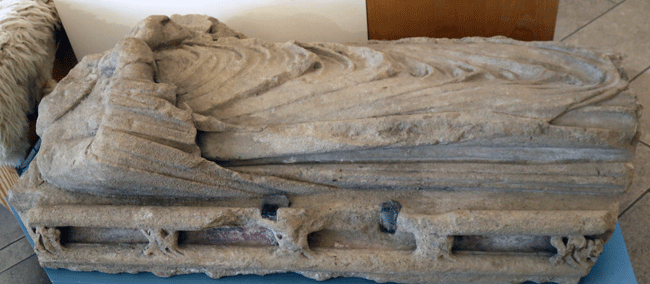 |
| Above: An abbot: note
this mitre. This was the effigy originally on display. Right: Abbot Michael of Amesbury (1236-52) In 1291 Adam of Damerham recorded that the tomb of Abbot Michael and that of Abbot Pederton lay before the altar of St Thomas in the north transept. John Leyland confirmed this when he visited the abbey in the 1530's |
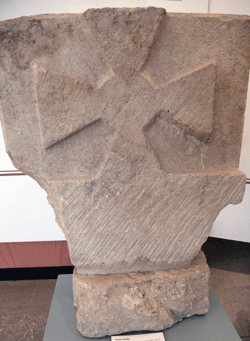 |
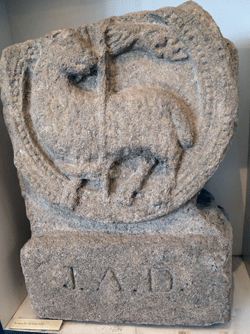 |
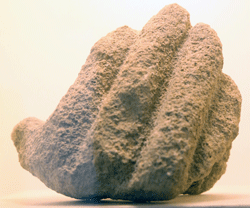 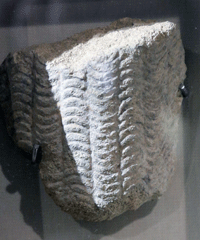 |
 Fragment of an effigy of a priest. |
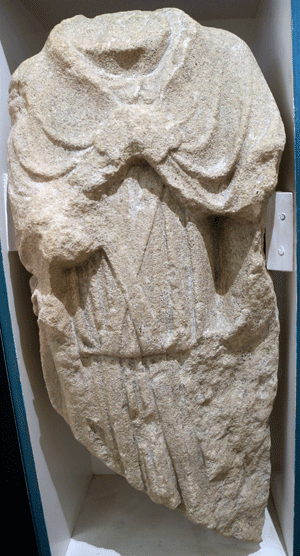 Fragment of an effigy |
| Above left and right:
Two graves markers. That on the right of J.A.D. Near right: Above is a part of a hand, probably from an effigy and below this mail from a limb. |
||||
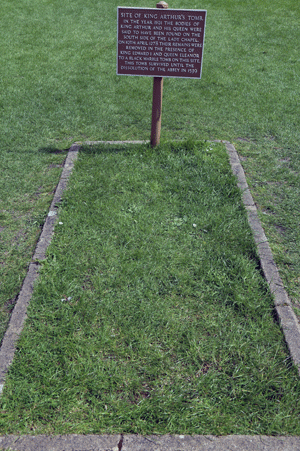 |
Left: Site of King Arthur's tomb. Whether the existence of King Arthur or the finding of his body by the monks of Glastonbury is to be believed, this was clearly a money spinner for the Abbey. There is still (2019) no marker or any mention in the Abbey of the burial of the three Anglo-Saxon kings mentioned above. In the guide book there is now a reference to these kings as well as a speculative drawing of the presbytery of the Abbey and the two kings' relatively simple floor monuments on either side of King Arthur's shrine as described in the early records |
| Abbots - Mitred or Not |
The abbot was (and is) the head of an abbey (larger monastery): the head monk. The word comes from the Latin - abbas (father) - and gives some ideas of his initial role. Until the end of the 7th century neither the monks nor even the abbot were ordained. They were therefore compelled to attend the nearby church in order to receive the sacraments from an ordained priest. This could have been a great inconvenience if the abbey was in a remote area so that some monks began to be ordained as deacons or priests. This move was resisted in some quarters as ecclesiastical dignity was deemed to be inconsistent with simple monastic life. The abbot was originally subject to the jurisdiction of the local bishop until the 11th century but then religious houses became partly or completely exempt from this episcopal control; this was mainly a result of the exorbitant claims of the bishops rather than arrogance of the abbots. Thus certain abbots became responsible to the Pope alone. This however created a state within a state and all the attendant problems. Some abbots - known as mitred abbots - had the right to wear episcopal insignia, such as the mitre, rings, gloves and sandals and carrying a crosier. The right was given by the Pope and the first known bull (papal charter) to confirm this was in 1063 which allowed Egelsway, Abbot of St Augustine's Abbey, Canterbury this privilege. As can be seen in the photograph of one of the effigies this right was also conferred on the abbot of Glastonbury but there were a number of others ⁻¹. As might be expected there was an order of precedence with Glastonbury being number one until 1154 when Pope Adrian IV - Nicholas Breakspear, the only English Pope - made St Alban's, where he had been reared - number one. The next in order was Ramsey. To distinguish an abbot's mitre from that of a bishop, the former were to be made of less costly material and there was to be no gold ornamentation; however this was soon entirely ignored. The crook the abbot's staff was of a different design to that of a bishop's to indicate the former's more limited jurisdiction. The adoption of bishops' insignia was followed by encroachment on episcopal functions so that by 1489 abbots were permitted to ordain men up to the order of deacon. If there occurred a vacancy in the abbot's office the monks had a right to elect from their own members the new abbot but it was in the power of the local bishop to confirm the election and deliver the benediction. If the abbey were exempt from the bishop's jurisdiction the abbot elect had to travel to Rome to receive confirmation and the benediction, an expensive procedure which was borne by the abbey itself. The candidate for the position of abbot had to be at least thirty years of age, legitimate and had been a monk at the particular abbey for at least ten years. Initially the abbot was, in a sense, first among equals, eating in the monks' refectory and sleeping in the monks' dormitory. The Rule of St Benedict allowed a separate table for the abbot to entertain guests and visitors so by the tenth century steadily the initial ideal of monastic life declined. As can be seen at Glastonbury the abbot eventually had his own kitchen and living quarters. Abbots originally wore the simple monks' habit but eventually began to wear more extravagant clothing and even secular dress. Finally they began to live the lifestyle of a great lord, spending time hunting and other pursuits of the upper classes, except, nominally at least, they were celibate. Nominally, because later abbots would employ staff including female housekeepers. If your surname happens to be Abbot, you are unlikely to be descended from a wayward abbot but rather from an abbot's servant or member of lay staff. ⁻¹ In England these were, in alphabetical order: Abingdon, St Alban's, Barney, Battle, Bury St Edmund's, Colchester, Croyland, Evesham, Gloucester, St Benet's Hume, Hyde (Winchester), Malmesbury, Peterborough, Ramsey, Reading, Selby, Shrewsbury, Tavistock, Thorney, Westminster, Winchcome, and St Mary's, York. |
|
|
Goathurst - St Edward |
|
| Church open normal hours. Park in the village; the church is at the end of the village O/S Ref: ST 256 344 |
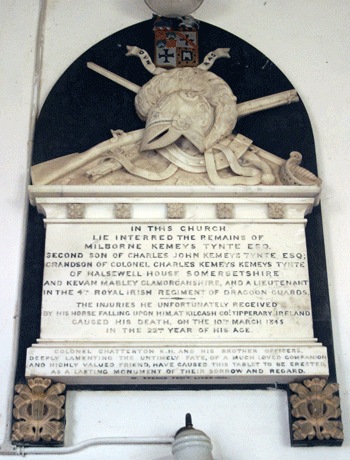 |
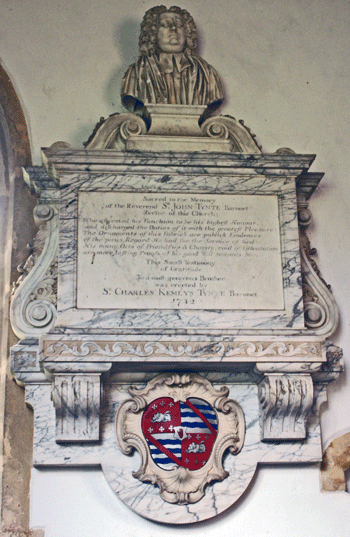 |
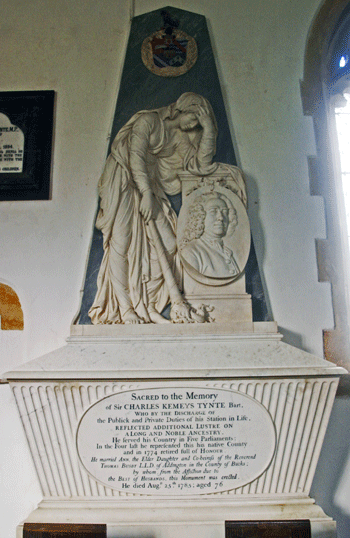 |
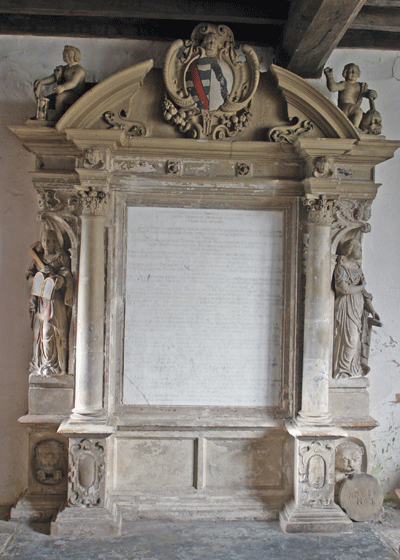 |
|
Above Left: Milborne Kemeys Tynte Esq (1845) Lt 47 Royal Irish Reg of Dragoon of Guards. Died in riding accident Above Right: Rev Sir John Tynte (1742) Rector 1731-1740 By J M Rysbrack Near Right: Sir Charles Kemys Tynte MP (1785) Younger brother of Sir John By Nollekens. Far Right: Sir Hugh Halswell Tynte & Other Members of His Family (1650). Latin inscription. Note the allegorical flanking figures of Faith & Hope; above are two cheubs, one with hour glass, the other with skull. |
|||
 |
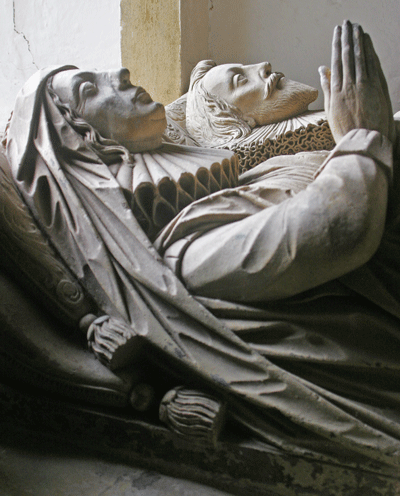 |
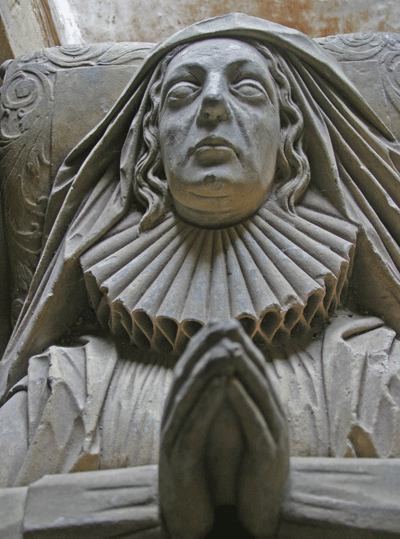 |
 |
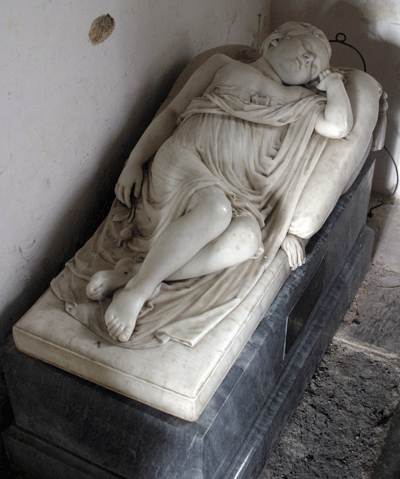 |
|
Above Top and Above Bottom Left:
Sir Nicholas (1633) & Bridget
(1627) Halswell. Around the tomb chest
keel 6 sons and 3
daughters; as only two side are used for this purpose we
may assume that the tomb is in its original position
tight against the wall. He was MP
for Bridgewater and JP; .in the latter role he imprisoned in 1603 'one John
Gilbert, alias Gogulmere, a fanatical minister, for
having...attempted to preach naked in...North Petherton' Above Bottom Right: Isabella Anne Kemeys Tynte (1835) She died aged 3. Marble by Raffaeli Monti |
|
